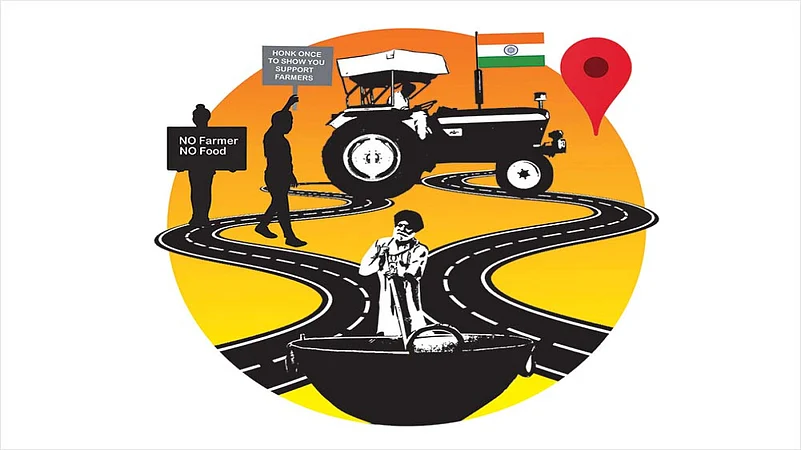Beyond the borders of the capital, a tapestry of sights and feelings give depth to our understanding of the farmers’ protest. A road journey from Delhi to the Wagah-Attari border and back reveals a kaleidoscope of emotions—anger, frustration, unity, bonding and, of course, perseverance. That an agitation can be peaceful and conducted without the help of a ‘toolkit’ or propelled by recklessness can be seen on the highways of Punjab and Haryana. The kinnow juice sellers even add a sweet and juicy taste to it!
The 500-km drive from Delhi’s ITO to Amritsar’s Golden Temple usually takes about nine hours even if you take two longish snack breaks en route. But Delhi Police, jittery after the chaotic Republic Day agitation, with a break-out to the Red Fort, has made travel till Sonipat, Haryana, a nightmare. Traffic is diverted well ahead of Singhu border and the road that cuts through the villages of Lampur are congested, unruly and risky. There are no metalled roads for long stretches. Probably caught in administrative wrangles between the governments of Delhi and Haryana, the narrow roads through Safiabad and Safoli are incomplete, resemble Himalayan rally roads and are a great test for your car’s suspension! A 90-minute drive is now a two-and-a-half hour ordeal.
Yet the parathas at Murthal are still flavourful—baked in the earthen ovens and served with dollops of white butter and curd, they make for a wholesome meal. The hot ginger tea boiled in buffalo milk and laced with sugar sets us up for a nostalgic drive to Panipat, Kurukshetra and beyond. On the way to Ambala, the granary of North India is in full view. The winter crop stands tall and the fertile fields of Haryana and Punjab are a vast expanse of green and yellow, with wheat and mustard gently swaying in the wind.
The historic National Highway 1—the Grand Trunk Road—now belongs to the farmers and their legions of supporters. NH1 is re-numbered as follows: Delhi to Jalandhar via Ambala and Ludhiana is NH44; beyond Jalandhar till Attari via Amritsar, it is NH 3. The six-lane roads are a beauty but for the tractors chugging on nonchalantly on the fastest track. NH44 reflects two sides of the same coin. While from Delhi to Jalandhar one sees farmers in tactical retreat, those whose ‘shift’ at Singhu is temporarily over, Jalandhar to Delhi is the track for their refreshed and advancing brethren, unbending till their demands are met. The road to Delhi is festooned with energy, colour and enthusiasm. The farmers have taken to heart Napoleon’s dictum: ‘an army marches on its stomach’. Every tractor has a covered trailer in tow. These have beds made on sheaves of hay—for men to cover themselves with heavy blankets and listen to music or surf the net. The poor internet coverage gets better beyond Karnal.
The farmers’ agitation gathers momentum from the outskirts of Jalandhar. Except for the industrial pockets of Phagwara and Kapurthala, the 225-km stretch of the highway till Panipat is like a Rajpath of marching farmers from Punjab. They drive their tractors with gusto, party flags cutting through the clean air like so many shark fins. Almost every car with a Punjab number plate sports a sticker—‘No Farmer, No Food’. Numerous stalls sell gaudy pennants of the various organisations participating in the rally. Colours range from Brazilian canary yellow and green, pure white and jet black. Then there is the tricolour—they fly in full splendour on a sunny, windy day, a unifying agent amidst the diverse patterns. The hundreds of fresh kinnow juice sellers only add to the colour.
The movement has received wholehearted support from the common man. With their langars and refreshment points at almost every toll booth on NH44, farmers and their supporters touch a humane chord with their genuine ‘sewa’. And everyone is invited. That someone doesn’t have to make noise to be heard is clearly evident at toll plazas. Little kids hold up placards, drawing the attention of motorists with smart slogans. ‘Honk once to show your support for farmers’, says one. Given the density of traffic on this highway, a veritable stream of ‘honks’ reflect unanimous, overwhelming support. The Punjab Police is friendly too. Tractors, regardless of their speed and paraphernalia, now have the right of way!
















